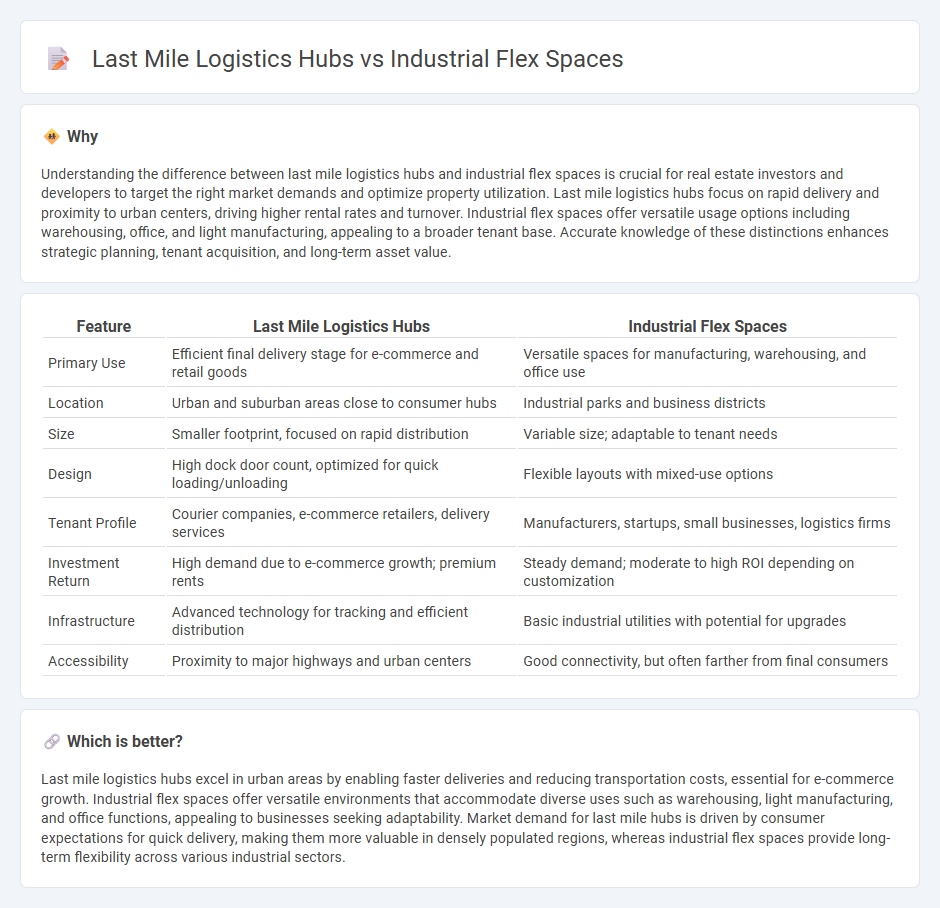
Last mile logistics hubs are specialized facilities designed to expedite the final delivery phase, often located near urban centers to meet growing e-commerce demands. Industrial flex spaces offer versatile environments adaptable for various uses including warehousing, manufacturing, and office functions, catering to businesses seeking operational flexibility. Explore the key differences and strategic advantages of each type to optimize your real estate investment.
Why it is important
Understanding the difference between last mile logistics hubs and industrial flex spaces is crucial for real estate investors and developers to target the right market demands and optimize property utilization. Last mile logistics hubs focus on rapid delivery and proximity to urban centers, driving higher rental rates and turnover. Industrial flex spaces offer versatile usage options including warehousing, office, and light manufacturing, appealing to a broader tenant base. Accurate knowledge of these distinctions enhances strategic planning, tenant acquisition, and long-term asset value.
Comparison Table
| Feature | Last Mile Logistics Hubs | Industrial Flex Spaces |
|---|---|---|
| Primary Use | Efficient final delivery stage for e-commerce and retail goods | Versatile spaces for manufacturing, warehousing, and office use |
| Location | Urban and suburban areas close to consumer hubs | Industrial parks and business districts |
| Size | Smaller footprint, focused on rapid distribution | Variable size; adaptable to tenant needs |
| Design | High dock door count, optimized for quick loading/unloading | Flexible layouts with mixed-use options |
| Tenant Profile | Courier companies, e-commerce retailers, delivery services | Manufacturers, startups, small businesses, logistics firms |
| Investment Return | High demand due to e-commerce growth; premium rents | Steady demand; moderate to high ROI depending on customization |
| Infrastructure | Advanced technology for tracking and efficient distribution | Basic industrial utilities with potential for upgrades |
| Accessibility | Proximity to major highways and urban centers | Good connectivity, but often farther from final consumers |
Which is better?
Last mile logistics hubs excel in urban areas by enabling faster deliveries and reducing transportation costs, essential for e-commerce growth. Industrial flex spaces offer versatile environments that accommodate diverse uses such as warehousing, light manufacturing, and office functions, appealing to businesses seeking adaptability. Market demand for last mile hubs is driven by consumer expectations for quick delivery, making them more valuable in densely populated regions, whereas industrial flex spaces provide long-term flexibility across various industrial sectors.
Connection
Last mile logistics hubs optimize the final stage of delivery by providing strategically located distribution centers that reduce transit times and enhance customer satisfaction. Industrial flex spaces cater to these hubs by offering adaptable environments for warehousing, fulfillment, and quick inventory turnover. The synergy between last mile logistics hubs and industrial flex spaces drives efficiency in supply chains and supports the growing demand for e-commerce fulfillment.
Key Terms
Zoning
Zoning regulations play a critical role in the development of industrial flex spaces and last mile logistics hubs, influencing land use, building specifications, and permitted activities. Industrial flex spaces often require mixed-use zoning to accommodate a combination of light manufacturing, office, and warehousing functions, whereas last mile logistics hubs demand zoning that supports heavy vehicle access, high traffic volumes, and sometimes extended operating hours. Explore zoning distinctions further to optimize site selection and compliance strategies for your industrial real estate projects.
Loading Dock Access
Industrial flex spaces offer versatile loading dock access designed to accommodate various tenant needs, while last mile logistics hubs prioritize optimized dock configuration for rapid turnover and high-frequency shipments. The strategic design of loading docks in last mile hubs supports efficient sorting, cross-docking, and quick vehicle loading to meet tight delivery windows. Explore how loading dock innovations enhance operational efficiency in both industrial flex spaces and last mile logistics hubs.
Proximity to Urban Centers
Industrial flex spaces offer versatile usage options and are strategically located near urban centers, enabling quick access to diverse markets and reducing transportation costs. Last mile logistics hubs focus on ultra-close proximity to densely populated areas to facilitate rapid delivery and improve customer satisfaction. Explore how these location strategies impact supply chain efficiency and operational agility.
Source and External Links
Industrial Flex Space: A Complete Investment Strategy - Industrial flex space refers to single-story buildings that combine warehouse-like industrial areas with office, retail, or showroom components, offering versatile spaces suitable for varied tenant needs such as production, storage, and administrative use, which minimizes vacancy risk and future-proofs investments.
What is Flex Industrial Space? Benefits & Investment Potential - Flex industrial space is a multi-functional commercial property combining office, retail, and warehouse use that supports co-working and shared amenities, offers lower startup costs, and is easily adjustable to the changing needs of businesses including light manufacturing and distribution.
Everything You Need To Know About Flex Space - Flex industrial space provides versatile and customizable layouts combining warehouse and office space in strategic locations, offering cost-effectiveness, scalability, and suitability for a wide range of commercial activities and business growth stages.
 dowidth.com
dowidth.com